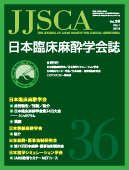Volume 36, Issue 1
Displaying 1-23 of 23 articles from this issue
- |<
- <
- 1
- >
- >|
Case Reports
-
2016 Volume 36 Issue 1 Pages 1-6
Published: January 15, 2016
Released on J-STAGE: February 12, 2016
Download PDF (635K) -
2016 Volume 36 Issue 1 Pages 7-10
Published: January 15, 2016
Released on J-STAGE: February 12, 2016
Download PDF (555K) -
2016 Volume 36 Issue 1 Pages 11-14
Published: January 15, 2016
Released on J-STAGE: February 12, 2016
Download PDF (522K) -
2016 Volume 36 Issue 1 Pages 15-19
Published: January 15, 2016
Released on J-STAGE: February 12, 2016
Download PDF (987K)
Brief Reports
-
2016 Volume 36 Issue 1 Pages 20-24
Published: January 15, 2016
Released on J-STAGE: February 12, 2016
Download PDF (386K)
Other Reports
-
2016 Volume 36 Issue 1 Pages 25-28
Published: January 15, 2016
Released on J-STAGE: February 12, 2016
Download PDF (282K)
Symposium (1)
-
2016 Volume 36 Issue 1 Pages 29
Published: January 15, 2016
Released on J-STAGE: February 12, 2016
Download PDF (134K) -
2016 Volume 36 Issue 1 Pages 30-34
Published: January 15, 2016
Released on J-STAGE: February 12, 2016
Download PDF (437K) -
2016 Volume 36 Issue 1 Pages 35-42
Published: January 15, 2016
Released on J-STAGE: February 12, 2016
Download PDF (1430K) -
2016 Volume 36 Issue 1 Pages 43-49
Published: January 15, 2016
Released on J-STAGE: February 12, 2016
Download PDF (1488K)
Symposium (2)
-
2016 Volume 36 Issue 1 Pages 50
Published: January 15, 2016
Released on J-STAGE: February 12, 2016
Download PDF (135K) -
2016 Volume 36 Issue 1 Pages 51-56
Published: January 15, 2016
Released on J-STAGE: February 12, 2016
Download PDF (1093K) -
2016 Volume 36 Issue 1 Pages 57-62
Published: January 15, 2016
Released on J-STAGE: February 12, 2016
Download PDF (379K) -
2016 Volume 36 Issue 1 Pages 63-71
Published: January 15, 2016
Released on J-STAGE: February 12, 2016
Download PDF (1299K)
Lectures
-
2016 Volume 36 Issue 1 Pages 72-78
Published: January 15, 2016
Released on J-STAGE: February 12, 2016
Download PDF (656K)
[JSIVA] Other Reports
-
2016 Volume 36 Issue 1 Pages 79-82
Published: January 15, 2016
Released on J-STAGE: February 12, 2016
Download PDF (338K)
[JARMA] Special Lecture
-
2016 Volume 36 Issue 1 Pages 84-91
Published: January 15, 2016
Released on J-STAGE: February 12, 2016
Download PDF (1080K)
[JARMA] Educational Lecture
-
2016 Volume 36 Issue 1 Pages 92-105
Published: January 15, 2016
Released on J-STAGE: February 12, 2016
Download PDF (3117K)
[JARMA] Other Reports
-
2016 Volume 36 Issue 1 Pages 106-116
Published: January 15, 2016
Released on J-STAGE: February 12, 2016
Download PDF (558K)
[JAMS] Seminar
-
2016 Volume 36 Issue 1 Pages 118
Published: January 15, 2016
Released on J-STAGE: February 12, 2016
Download PDF (170K) -
2016 Volume 36 Issue 1 Pages 119-126
Published: January 15, 2016
Released on J-STAGE: February 12, 2016
Download PDF (1162K) -
2016 Volume 36 Issue 1 Pages 127-133
Published: January 15, 2016
Released on J-STAGE: February 12, 2016
Download PDF (1156K)
Column
-
2016 Volume 36 Issue 1 Pages 134
Published: January 15, 2016
Released on J-STAGE: February 12, 2016
Download PDF (159K)
- |<
- <
- 1
- >
- >|
